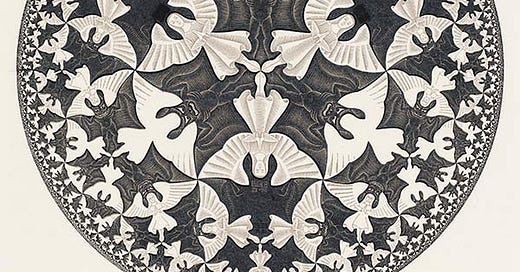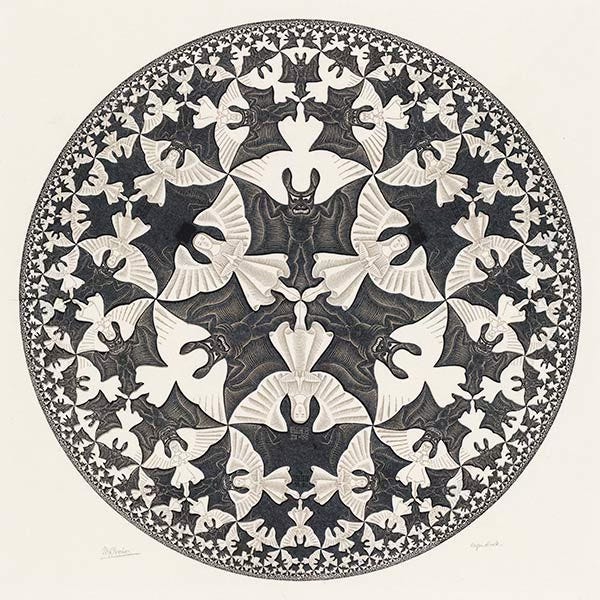This is going to be a different kind of post. I am introducing a new long-form project I am working on, feedback is very welcome!
“Longing for the beautiful leads us to the same choice as longing for the useful”
— Henri Poincaré (Science and Method, transl. George Bruce Halsted)
I call this space “Mundane Beauty” because of a belief that humans have an innate propensity to imbue the world with their contemporary understanding of plaisir (delight/joy/contentment/pleasure). History is but our method of investigating these changing notions and expressions of beauty so that we may better know ourselves. Similarly, science, at-least for a long time, was thought of as a tool to understand the wonders of the natural world (ref; the idea of God-given beauty in the West). Naturally, there is some (significant) overlap between the aesthetics we hold dear and those we are able to observe in the universe. I guess there is a reason why people who made this intersection of the past and the future their vocation were called ‘humanists’ in the Renaissance.
However, just because Ancient Greek poetry is no longer a prerequisite for a scientific education (as was the case for the humanists), does not mean that modern-day STEM draws any less from the ‘standard of beauty’ we express so freely in our artistic traditions. We are just less conscious of it.
This became apparent to me when a friend of mine (Hi Samarth!) started working towards teaching himself math equivalent to doing an “unofficial undergraduate major.” Often, he would use words like ‘elegant’ or ‘beautiful’ to describe certain proofs he found pleasing just as he would use ‘ugly’ and ‘non-intuitive’ to characterize those that did not seem as clear to him. This vocabulary is but a feature of the field of mathematics which relies heavily on non-verbal, implicit ideas of beauty, often to epistemic ends. Generalizable, symmetric, eliciting-the-feeling-of-placing-the-final-piece-in-an-incomplete-puzzle (and I am sure there are plenty of other ways of defining mathematical beauty) proofs have consensus around their truth sooner. Ugly ones less so, often being subject to many iterations of reframing till a certain standard is met [Euclid’s fifth postulate is a very good example and I will talk about it more in a later essay]. More astoundingly, this superficial heuristic tends to be a generally good indicator of both verity and usefulness. Is this phenomenon not worth investigating?
It is in following this train of thought that I stumbled into the works of Henri Poincaré — a giant in the French mathematical scene in the late 19th and early 20th centuries. He is best known for being the ‘father of topology' due to his vast contributions to that sub-field but he also dabbled in early non-euclidian geometry, math related to the study of relativity, geodesy, and most importantly for my purposes: publicly accessible philosophy of science. It was this philosophy that made coherent the underlying mechanisms of doing math and attempted (at-least briefly) to elucidate why exactly aesthetics mattered in STEM.
“It is, therefore, the quest of this especial beauty, the sense of the harmony of the cosmos, which makes us choose the facts most fitting to contribute to this harmony, just as the artist chooses from among the features of his model those which perfect the picture and give it character and life.” — Poincaré (Science and Method, transl. George Bruce Halsted)
Concurrently, while I was making my first pass through his written work, I was asking those around me to explain one mathematical concept they found beautiful and what made it so [I would be incredibly grateful here if you took a moment to fill out the following with more of the same questions: form]. Here there was an interesting conflation between geometry (both Euclidean and not) and beauty — most likely because of its visual nature. More specifically, a lot of the math Poincaré influenced elicited these feelings of delight.
My hunch here is that those who were conscious of the philosophical value of their work often implicitly perpetuated those ideas even in their more technical presentations.
This leads us to what I am trying to do: In following this hunch, I am trying to write a history of mathematical aesthetics. For practical reasons (time mostly), I am limiting the scope to finding the ‘standard of beauty’ within the brief history of non-Euclidian geometry. I will move from Gauss to Poincaré to see how the evolution of the field demanded a focus on aesthetics. Subsequently, I will show the link between that story and Poincaré’s philosophy of science (relying on my own close readings alongside secondary scholarship). Lastly, time and space in my senior thesis permitting, I want to provide an overview of Poincaré’s influence on mathematical teaching after him — i.e. why is he still relevant today and why should we care about beauty in STEM more broadly?
This work has led me to France, and I am in Paris till the 20th of July doing archival research: if you happen to be here and are interested in the questions I am asking [or think they are not particularly novel/worthwhile], I would be very happy to discuss things further over coffee. Please send me an email at jainhiya1212@gmail.com, alternatively, my DMs are open on Twitter.
I will also continue writing about the story on this blog as it becomes clearer to me, often including full excerpts from the final work. Feedback would be very helpful!
With special thanks to everyone at Archives Henri Poincaré at Univ de Lorraine, Nancy 2 (especially Prof Laurent Rollet and M. Pierre Willaime) for their help over the past week. Not only were they very helpful with resources, but conversations with them were immensely productive in finding the story-of-best-fit so to speak.





